Wild garlic/Ramsons – Edibility, Identification, Distribution, Recipes
Allium ursinum
- Edibility – 3/5 – tasting strongly of spring onions and garlic. All of the plant is edible, including shoots, leaves, buds, flowers, flowering stems bulbils, seeds and bulbs/roots, though the latter should not be dug up as they tend to lack flavour/texture and you will be undermining future populations.
- Identification – 3/5– related species include few-flowered leek (allium paradoxum) and three-cornered leek (allium triquertum) which have narrower leaves. Both are good to eat but lack the flavour of garlic. You should also be aware of lords & ladies (arum maculatum) and lilly of the valley (convallaria majalis) – the former being very astringent in the mouth, so unlikely to be consumed in any quantity. Lilly of the valley contains nearly 40 cardiac glycosides and is potentially deadly. Read more about them below.
- Distribution – 4/5 – Abundant, often hyper-abundant.
- Season – February – June
- Habitat – Shady hedgerows and open, well established deciduous woodland. Less common in Northern Scotland
Along with wood sorrel, wild garlic has been at the forefront of the renaissance in wild foods in recent years. It isn’t hard to work out why: it is easy to find, delicious, and fairly straightforward to identify. In most areas of the UK, there is absolutely no need for anyone who lives anywhere near a park, woodland or shady riverbank to spend a single penny on spring onions between February and July. This is an abundant plant, though I have heard the closely related ramps (allium tricoccum) are suffering in some areas of the US near to urban centres, where they are usually dug up. Though it isn’t really worth uprooting wild garlic, I expect populations near some urban areas will start to suffer as foraging continues to increase in popularity. I would urge anyone to pick considerately, not clearing large areas, but spreading their picking and increasing their repertoire of foraged edibles.
Its crowded ranks of sleek, lanceolate leaves can carpet large expanses of woodlands, filling them with nodding white starburst flowers and the smell of garlic. We have a small mountain in Galloway named Garlick Hill – unfortunately, now given over to plantation forest – which I assume must have been blanketed in it once.
As you might expect of the allium family (which includes onions, garlic, leeks etc), the flavour is a delightful combination of garlic and spring onions. Early shoots, like most wild greens, are the most pungent – though never too overpowering. The flavour of the leaves mellows and their texture coarsens as the season goes on and pass their best once they flower. The flowers are also edible, and make the finest natural garnish I could possibly imagine. If you pick them early in the season when they nestle in the young leaves they are elegant and delicate, still wrapped in their translucent sheathe and make tremendous pickles.
Garlic has famously been employed to deter vampires. As with many legends, this has a basis in more practical traditional uses as a blood purifier and the pungency of its active compounds to deter blood-suckers. The juice of most alliums can be useful in deterring biting insects. To be honest, I favour a midge net, and be warned, smearing yourself in wild garlic juice may see off more than just a few insects!
The flavour of alliums that we now hold in high esteem is actually a defence evolved to deter grazing. Unmolested pre-flowering alliums tend to be more or less odourless. The second they are cut, bitten or otherwise damaged, the enzyme alliinase converts alliin into allicin, which is responsible for the pungent garlic and onion flavours so appealing to most humans, but reprehensible to grazing animals (this is why wild garlic patches only really start to make the whole woods smell of garlic when they are well on in their growth cycle – essentially because they are starting to decompose). Allicin is actively toxic to many animals, reducing the bloods capability to carry oxygen. Don’t let your dog eat wild garlic.
This clever defensive strategy is a real own-goal when the onion family meets humans. As well as being delicious, allicin and other compounds found in alliums such as kaempferol and quercetin, have proven anti-bacterial, anti-fungal and anti-viral properties. They can be useful in the treatment of everything from bites, wounds and headaches, to heart diseases, cancer, viruses and lots more.
In a bush-medicine context, you’d do well to consume plenty of raw allium greens and bulbs for their gentle, natural antibiotic and antiviral properties, as well as their all-round nutritional profile. Laying the bruised leaves or rubbing the juice of say, wild garlic, on cuts and sores can only help, perhaps in conjunction with ribwort plantain (plantago lanceolata).
The one part that isn’t worth eating is the bulbs. If you are hoping for something resembling cultivated garlic, you’ll be disappointed. They tend to be wet, slippery and lacking much of the appeal of the rest of the plant. Not generally worth the trouble, though on a few occasions when I have found them washed out by flooding in early spring, then dried a little through exposure, they have made good pickles – a la pickled onion.
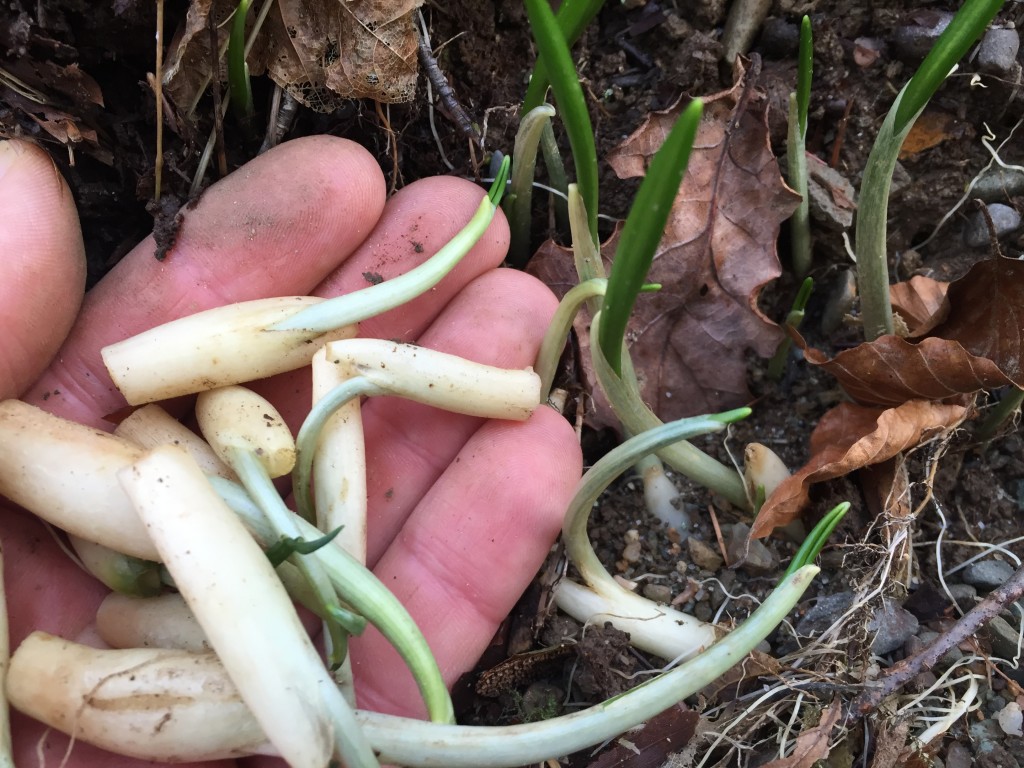
Wild garlic bulbs – not recommended for digging up, but if they get washed out, seems a shame to let them perish…
Ramsons – to use their more poetic name – are versatile in the kitchen. Their pungency works well in a variation on pesto, and you can make it extra wild if you use pig nuts or hazelnuts. They are very happy in the company of goats cheese and I use a hard Galloway goats cheese instead of parmesan.
Recipe: Wild Garlic, hazelnut and goats cheese pesto
The broad leaves can be used to wrap and layer – I have successfully used it to make dolmades and sushi rolls. It is possible to make excellent sauces and soups, but the oils that give ramsons their allium flavour are highly volatile and soon lost during cooking. I have come across too many misguided chefs bragging about their use of wild garlic, who have cooked every last vestige of taste out of it. I do sometimes sweat the white stems as a background flavour, but always add the freshly shredded green leaves at the last second to retain their garlicky aromatics.
Delightful as ramsons are, the flavour can be a little one-dimensional. It is possible to elevate them (and other alliums, or most wild vegetables for that matter) to spectacular new levels by lacto-fermenting them. This may sound daunting, but is in fact one of the simplest and most rewarding preparations, and means you can enjoy an allium buzz all year round.
Recipe: Lacto-fermented Wild Garlic
I said ramsons are fairly straightforward to identify as there are a couple of potential traps waiting for foragers who get over-confident or slap-dash in their picking. The worst (and hopefully most unlikely) mistake would be to gather a couple of early basal leaves of foxglove while picking carelessly. It is not that the leaves are particularly similar (thick, hairy and serrated rather than thin, sleek and smooth), just that they can grow in amongst ramson patches where coarse foragers may be tempted to tear up indiscriminate armfuls. Much more similar are Lilly of the Valley, Autumn Crocus, daffodils, snowdrops and Lords and Ladies. All of these are toxic to humans. None have the distinct scent of garlic, but as ramsons become the wild food of the masses, there will almost certainly be incidents inyears to come.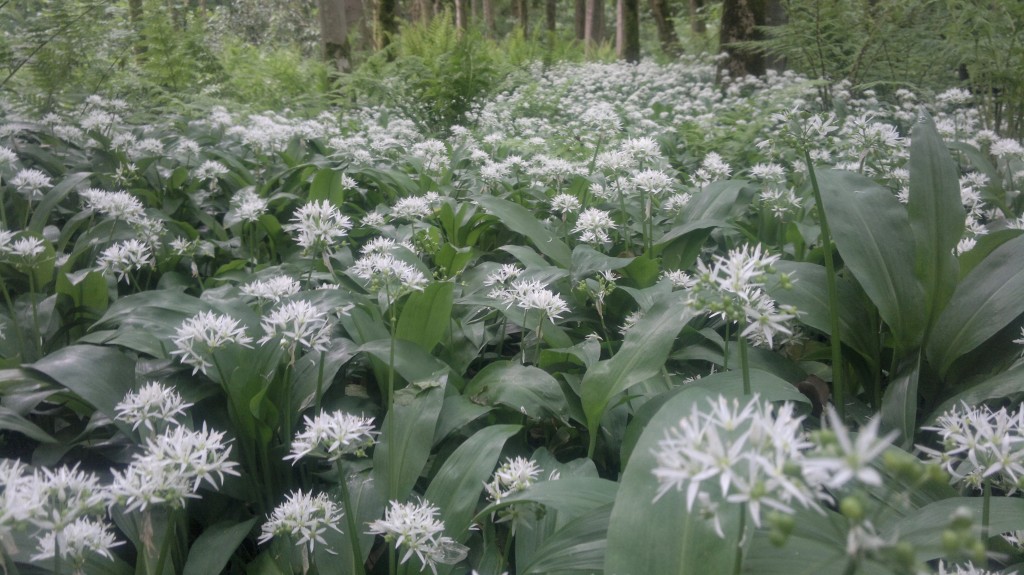
Related Pages:
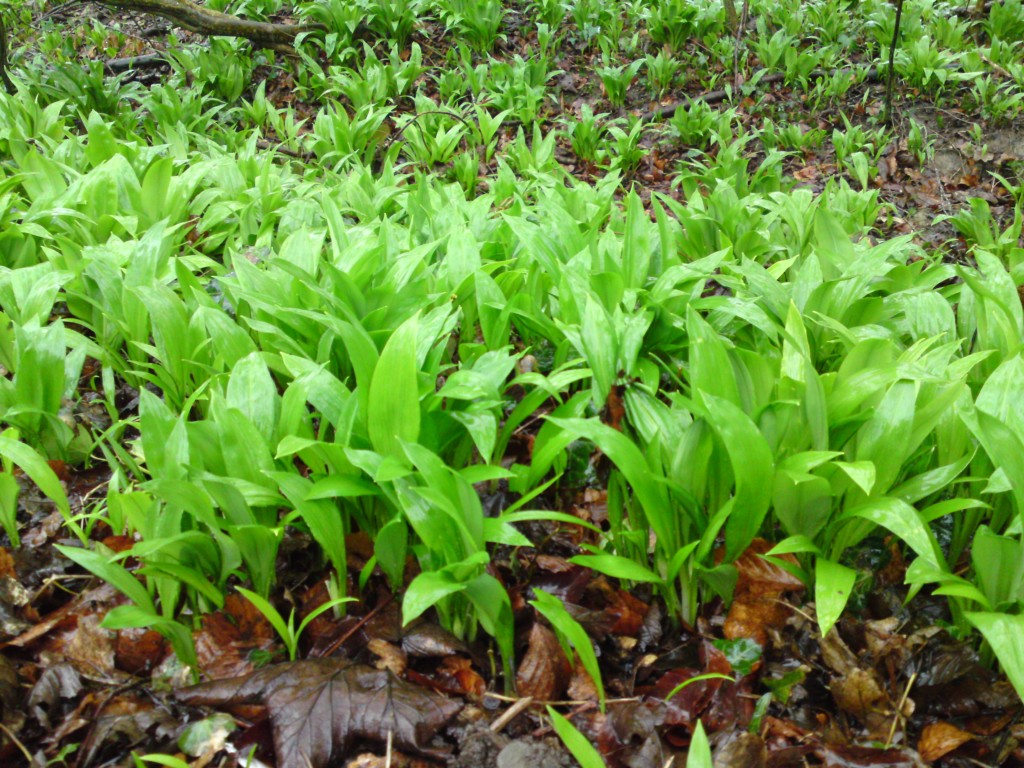
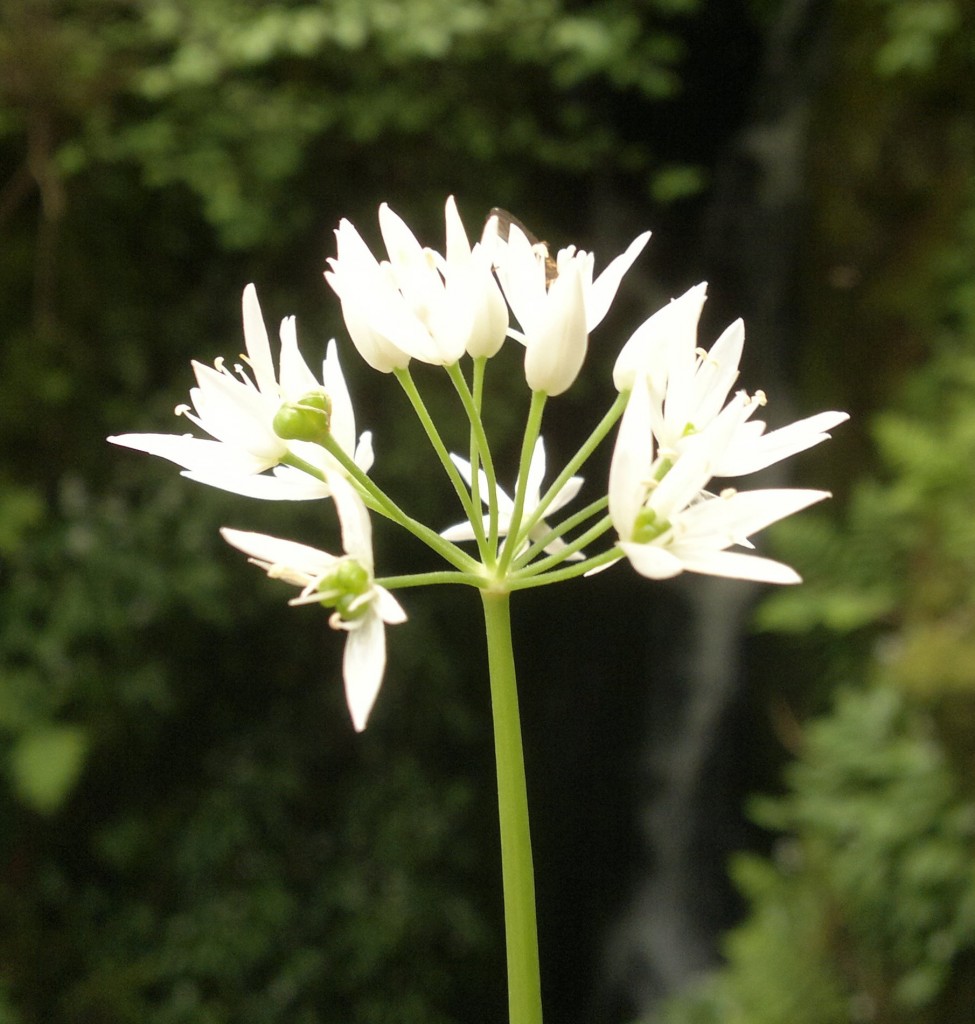

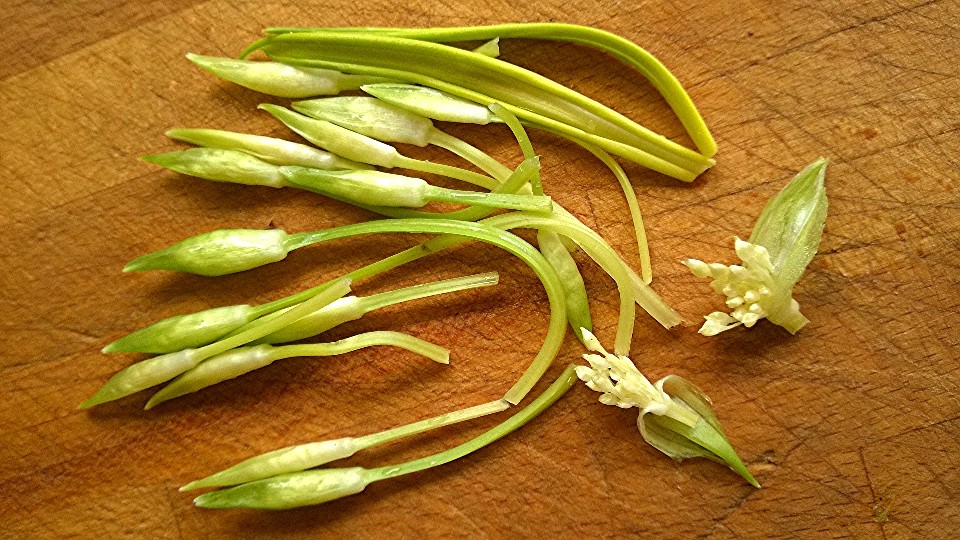
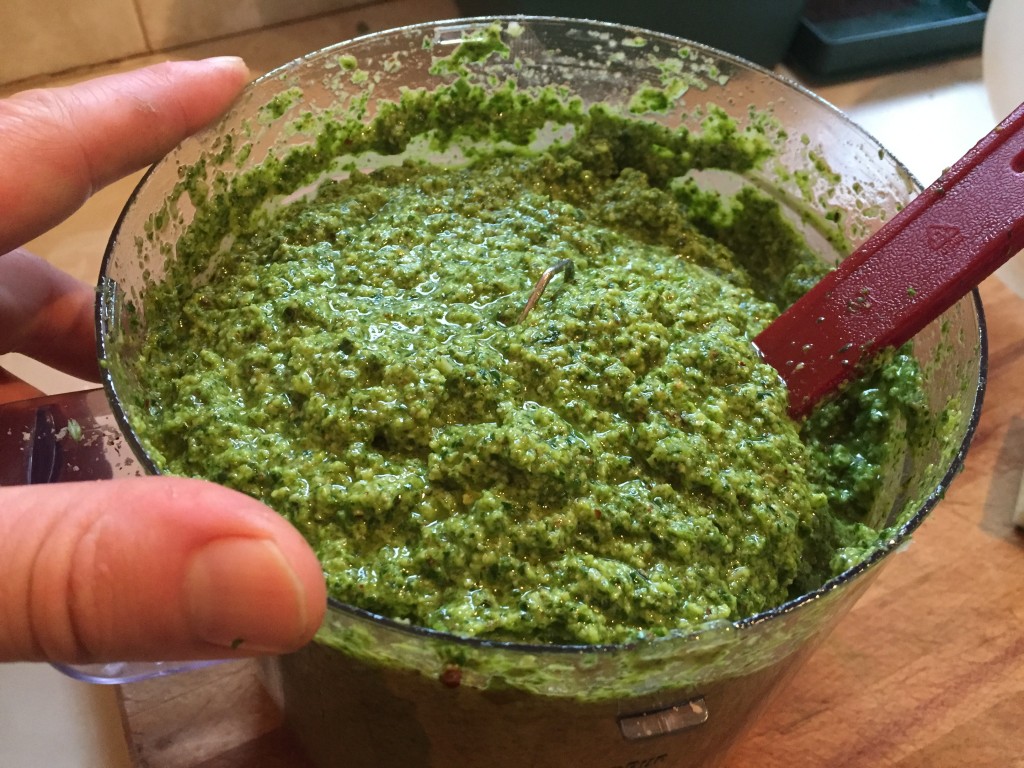
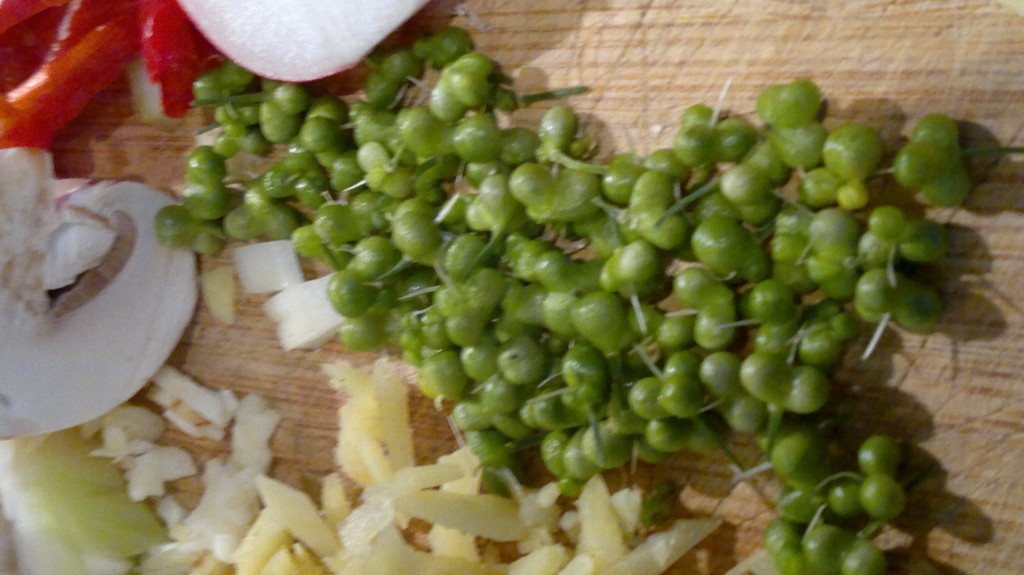
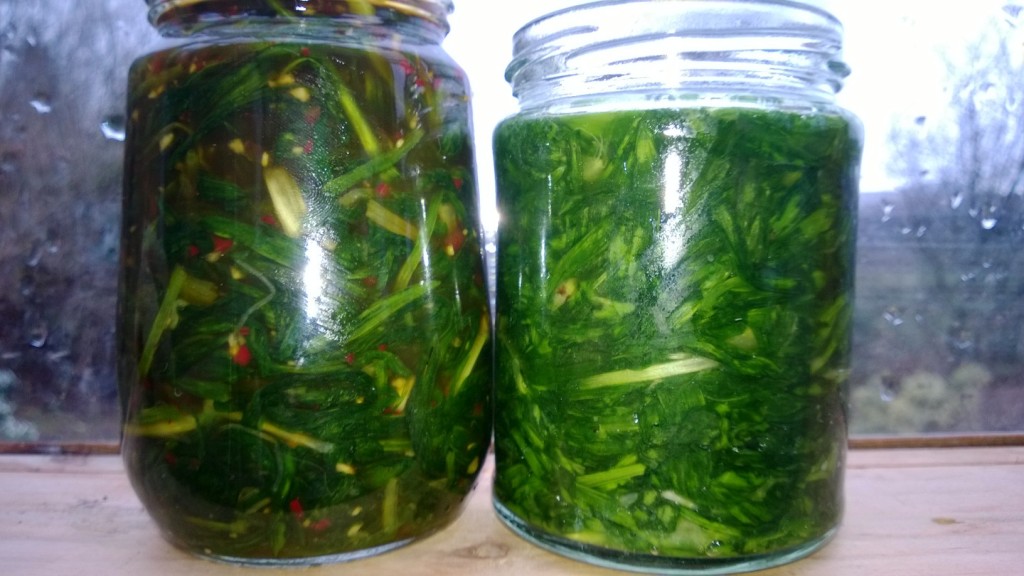
5 Comments
Great article. one of my favourite wild foods. The flowers are a lovely addition to salads and the early leaves are available as early as janurary. A great addition to muscles and your spot on when you talk about adding them at the last minute. dont wanna miss out on the flavour. They also keep really well in the fridge. bang them in a ziplock fridge bag and they really do keep for weeks. nice one Mark!
This is interesting.
About this wild garlic, they have many different name.
I know there are huge popular in U.K. or Northern Europe & Russia.
But some people found them here in northern Michigan.
It is very impressed.
Thank you for nice photos.
I hope some companies sell this wild garlic pickling.
It is very healthy food.
Specially people who like red meat.
I have seen a couple of recipes for pickled buds from the wild garlic, does anyone know what you would serve them with?
Anything that is nice with a garlicy pickle… cheese? Salad? Side on a stir fry? Sushi?